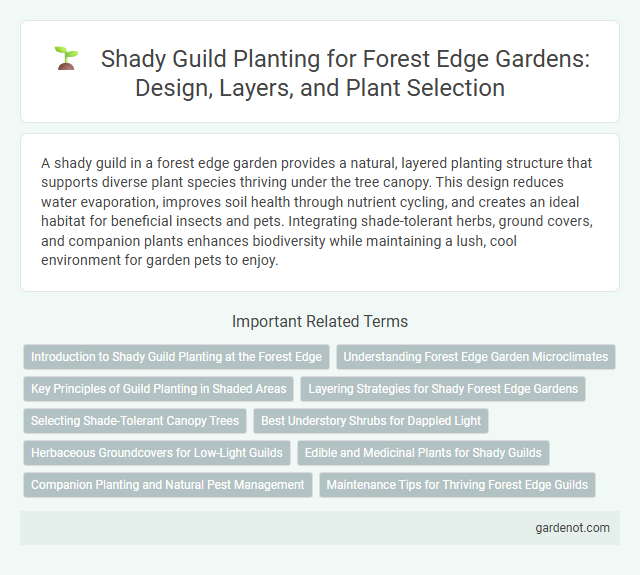A shady guild in a forest edge garden provides a natural, layered planting structure that supports diverse plant species thriving under the tree canopy. This design reduces water evaporation, improves soil health through nutrient cycling, and creates an ideal habitat for beneficial insects and pets. Integrating shade-tolerant herbs, ground covers, and companion plants enhances biodiversity while maintaining a lush, cool environment for garden pets to enjoy.
Introduction to Shady Guild Planting at the Forest Edge
Shady guild planting at the forest edge creates a thriving ecosystem by combining shade-tolerant plants, nitrogen fixers, and dynamic accumulators that improve soil fertility and structure. This approach mimics natural forest succession, enhancing biodiversity while providing edible, medicinal, and groundcover species that protect roots and retain moisture. Key components include shade-loving perennials like hostas and ferns, nitrogen-fixing shrubs such as alder or goumi, and nutrient-rich comfrey or yarrow to sustain healthy growth in low-light conditions.
Understanding Forest Edge Garden Microclimates
Shady guilds thrive in forest edge gardens by leveraging the unique microclimates created by the transition between dense forest and open areas. These microclimates offer moderated sunlight, cooler temperatures, and higher humidity levels, ideal for shade-tolerant plants like ferns, hostas, and medicinal herbs. Understanding these conditions allows gardeners to select complementary species that support soil health, moisture retention, and biodiversity within the shaded understory.
Key Principles of Guild Planting in Shaded Areas
Shady guilds thrive by combining shade-tolerant plants that fulfill varied ecological roles such as nitrogen fixation, ground cover, and pest deterrence. Key principles include selecting species adapted to low light conditions, ensuring complementary root structures to minimize competition, and promoting biodiversity to enhance soil health and resilience. Proper layering with tall shade trees, mid-height shrubs, and ground covers maximizes space and resource efficiency in forest edge gardens.
Layering Strategies for Shady Forest Edge Gardens
Layering strategies in shady forest edge gardens involve planting vegetation in vertical tiers to maximize space and light utilization. Incorporating ground covers, shade-tolerant shrubs, and shade-loving canopy trees such as oaks or maples creates a diverse ecosystem that supports beneficial insects and improves soil health. Utilizing native species like ferns, hostas, and woodland wildflowers enhances biodiversity while maintaining a natural forest edge aesthetic.
Selecting Shade-Tolerant Canopy Trees
Selecting shade-tolerant canopy trees for a shady guild in a forest edge garden enhances biodiversity and creates a balanced microclimate. Species such as American beech (Fagus grandifolia), Eastern hemlock (Tsuga canadensis), and Sugar maple (Acer saccharum) thrive in low-light conditions while providing essential canopy cover. These trees support understory plants by moderating temperature, retaining soil moisture, and enriching the habitat for pollinators and beneficial wildlife.
Best Understory Shrubs for Dappled Light
Best understory shrubs for dappled light in a forest edge garden include azaleas, hydrangeas, and witch hazel, all thriving in partial shade with filtered sunlight. These shrubs provide seasonal interest through vibrant blooms, fall foliage, and textured foliage while supporting local pollinators and enhancing biodiversity. Planting a shady guild with these species promotes soil health by improving organic matter and creating a microhabitat beneficial for forest ecology.
Herbaceous Groundcovers for Low-Light Guilds
Herbaceous groundcovers in shady guilds thrive under forest edges by suppressing weeds and maintaining soil moisture in low-light conditions. Species such as sweet woodruff (Galium odoratum) and wild ginger (Asarum canadense) provide dense, low-growing foliage that stabilizes soil and supports nutrient cycling. These plants adapt well to dappled shade, offering effective erosion control and habitat for beneficial insects within forest-edge ecosystems.
Edible and Medicinal Plants for Shady Guilds
Shady guilds in forest edge gardens often incorporate edible and medicinal plants such as ginseng, ramps, and goldenseal, which thrive in low-light conditions while providing valuable nutrients and therapeutic benefits. These plants create a layered canopy that supports soil health, promotes biodiversity, and offers natural pest resistance. Integrating species like mint and comfrey enhances both medicinal use and soil enrichment, making the shady guild a sustainable and productive ecosystem.
Companion Planting and Natural Pest Management
The shady guild in a forest edge garden combines shade-tolerant plants like ferns, hostas, and wild ginger to create a thriving ecosystem through companion planting. These plants establish natural pest management by attracting beneficial insects such as ladybugs and lacewings, which control aphids and other pests without chemicals. Incorporating nitrogen-fixing species like clover enhances soil fertility, promoting healthy growth in low-light conditions.
Maintenance Tips for Thriving Forest Edge Guilds
Shady guilds at the forest edge thrive with consistent mulching to retain soil moisture and suppress weeds, enhancing plant health and growth. Regular pruning of understory plants improves air circulation, reducing fungal risks and promoting robust root development. Incorporating nitrogen-fixing species and monitoring soil pH ensure nutrient balance vital for the guild's long-term productivity.
Shady guild Infographic

 gardenot.com
gardenot.com